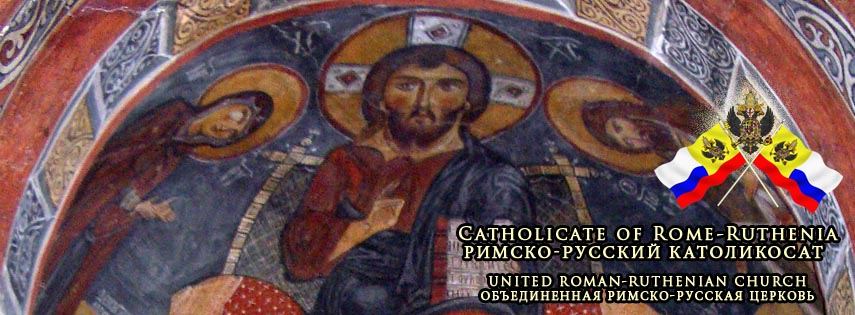THE DIOCESE OF THE SOUTHWEST 1978 - 2009.
THE ANGLO-CATHOLIC ARCHDIOCESE OF THE SOUTHWEST FROM 2009-2011.
SEE OF ST. STEPHEN, COADJUTORSHIP OF ROME (FOUNDED FIRST CENTURY BY ST. PETER),
AND SEE OF AQUILEIA (FOUNDED FIRST CENTURY BY ST. MARK) FROM 2011.
THE APOSTOLIC SEE OF STS. STEPHEN AND MARK FROM 2023.
In Hereditary Descent from Rome and Russia and Apostolic Succession
from Saints Peter, Andrew, Thomas, Thaddeus, and Bartholomew,
AN ETHNO-RELIGIOUS NATION WITHOUT POLITICAL TERRITORY AND A STATE UNTO ITSELF
representing people across multiple modern political countries.
PRINCIPAL LITURGICAL RITES:
GALLO-RUSSO-BYZANTINE
ANGLICAN-BYZANTINE
ANGLO-ROMAN
GALLICAN
Organisation in Special Consultative Status with the
United Nations Economic and Social Council since 2019.
The United Roman-Ruthenian Church is an autocephalous Apostolic church of ancient origins and Orthodox and Catholic heritage. The Church, today an ethno-religious minority, has its origins in the ancient Apostolic Churches of Rome, Constantinople, Syria, Russia, Alexandria, and Armenia. Representing a rare convergence of Apostolic faith and tradition that is both Orthodox and Catholic, it is both Western and Eastern. Though the United roman-Ruthenian Church stands on its own, it has received confirmation of its autocephalous and canonical status from various ecclesiastical and secular authorities over the years. (See also the legacy of the Independent Catholic Church International, Anglican Diocese of the Southwest, and multinational Orthodoxy.) Though of Roman-Syrian-Byzantine origins, the Apostolic See steadfastly keeps to the idea that all are welcome in Christ, whether Catholic, Orthodox, Protestant, or any believer in Christ.
Its modern history began with the restoration of the Anglican Diocese of the Southwest in 2008. The diocese was originally a part of one of the "continuing Anglican communities" known as the Anglican Catholic Church. It left that group and was part of two others -- the Anglican Church, Inc. and the American Episcopal Church (not to be confused with the Episcopal Church of the USA). Its second bishop, Saint Edwin Caudill, is considered the Apostolic Founder of the Diocese and Catholicate of Rome-Ruthenia and indeed of the United Roman-Ruthenian Church because he brought the diocese into orthodox and old catholic Apostolic tradition. Later his diocese continued that tradition as part of the Apostolic Communion of Anglican Churches.
 |
| Saint Edwin Caudill bringing his diocese into Orthodox and Old Catholic tradition through consecration by the Supreme Pontiff of the Philippine Independent Catholic Church. |
| Icon of Saint Edwin Caudill commissioned by the Diocese of Rome-Ruthenia |
The active expression of our Roman heritage of Old Catholicism was brought to the forefront in 2011, and the Anglican Patriarchate was formally established and recognised the same year. In 2019, the Apostolic See of Saints Stephen and Mark was established through the joining of the See of St. Stephen (also known as the Coadjutorship of Rome, into both of which Saint Edwin's Diocese of the Southwest had evolved) and the Anglo-Roman Metropolitan See of Aquileia, part of the Holy Roman Empire patrimony of the Church. Also in 2019, the United Roman-Ruthenian Church (under the name of its foundation at the time, the Anglican Rite Roman Catholic Church, Inc.) was admitted to special consultative status with the United Nations Economic and Social Council. Today the Apostolic See of Sts. Stephen and Mark is considered synonymous with the Diocese of Rome-Ruthenia.
Above: The Holy Fathers of the Apostolic See, St. Aftimios Ofiesh (left) and St. Leo X (right)
Find out more here.
Find out more here.
Finally, the Eastern Orthodox and Oriental Orthodox heritage of our identity was brought into the forefront starting in 2020 with Byzantine Roman customs, in 2021 with the re-establishment of the Gallican Rite (a tradition in France and Spain with origins in Greece and Antioch now centred in Argentina and affiliated with the Merovingian Dynasty), and finally with the newly-compiled Gallo-Russo-Byzantine and Anglican-Byzantine Rites the following year.
In 2022, the unification of our ethno-religious heritage was complete, and the dream had been realised, keeping with the wish of Our Lord Ut unum sint – that all may be one.
Over the years, the United Roman-Ruthenian Church and its various jurisdictions and organisations around the world established religious orders, built parishes and religious communities, grew chaplaincies servings the poor and vulnerable, expanded vocations, built service organisations to facilitate and promote humanitarian work, carried out significant historical preservation work, engaged in extensive diplomatic work, and published a substantial collection of liturgical, theological, and historical books. In the words of Bishop Rutherford I, "Our mission is the establishment of the Kingdom of God on earth. Our method is to empower people to build on their strengths, achieve their full potential, and do good in the world."
A SPIRITUAL AND CULTURAL FORCE FOR PAN-SLAVIC ROMAN UNITY.
Find out more here.
FOR MORE INFORMATION, PLEASE SEE THESE LINKS:
History of the United Roman-Ruthenian Church
Frequently Asked Questions
Government (Patriarchal Curia)
Pontifical Court
Dynastic Orders of Chivalry
Knight Bachelor of Yugoslavia
King Peter II and the Yugoslavian Heritage of the Church
Pontifical Georgian College
The Pontifical Society
Pontifical Post
Saint Edwin Caudill, Apostolic Founder and Confessor
History of the Diocese of the Southwest
Pontifical Apostolic Library and Stephenian Archives
Pontifical and Imperial Kingdom of Italy
Pontifical Kingdom of Ruthenia
Imperial Roman-Ruthenian Chronicler King of Arms








